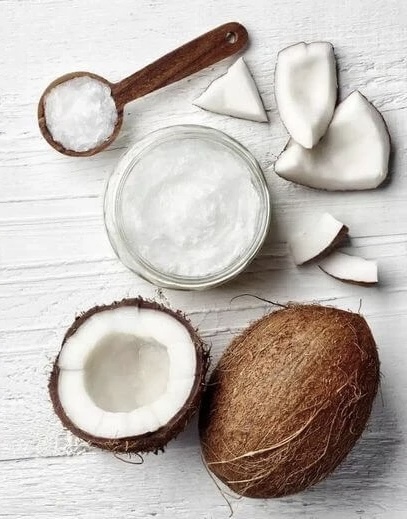
Indonesia is an agricultural powerhouse, with rapidly growing industries in coffee, cocoa, spices, and coconut oil. Leading the pack is coconut oil, supported by the country’s geography and favorable climate, which allows coconut palms to thrive abundantly. These trees grow primarily in coastal areas, enhancing the quality of both the roots and the fruit.
Statistics and Prospects

Indonesia is the global leader in coconut plantation coverage, with 3.88 million hectares of land, 97% of which are small-scale farms. These plantations produce 3.2 million tons of copra (dried coconut meat) annually. Beyond copra, nearly every part of the coconut tree is utilized:
- Virgin Coconut Oil (VCO) and secondary oils are extracted from copra.
- Nata de coco (coconut jelly).
- Serundeng (fried grated coconut served with rice).
- Coconut water: A refreshing beverage popular domestically and for export.
- Coconut milk: A staple in Asian cuisine and an export product.
- Coconut shell and husk: Used to make furniture, utensils, charcoal, and other goods.
Major Coconut-Producing Regions
Coconut palms grow throughout Indonesia, but the primary regions include:
• Riau, Sumatra: A leader in coconut production.
• Java: A traditional hub of the coconut industry.
• Sulawesi and Maluku: Emerging regions for coconut cultivation.
Key contributors to production include:
• Riau Province: 380,000 tons (11.92%).
• North Sulawesi: 265,000 tons (9.33%).
• East Java: 235,000 tons (9.17%).
• North Maluku: 206,000 tons (7.95%).
• Central Sulawesi: 191,000 tons (6.77%).
The remaining 54.86% is distributed across the country. North and East Lombok also hold significant potential, with 9,060 hectares of coconut plantations contributing to Indonesia’s export economy.
Production Growth
• Historical Growth: In 1974, Indonesia had 174,000 hectares of coconut plantations, which grew to over 3.5 million hectares by 2024, producing 15 million tons annually.
• 2024 Output: Coconut oil production reached 1.2 million tons, surpassing previous years.
Indonesia is a major global supplier of coconut oil, meeting a global demand of 25 million tons. Key export destinations include the USA, China, the EU (Germany, Netherlands, France, UK), India, Japan, South Korea, and Australia. Coconut oil is widely used in food and cosmetics, driving international demand.
Challenges in Coconut Oil Production
Despite its potential, the industry faces hurdles:
1. Infrastructure Gaps: Many regions lack sufficient processing and distribution facilities.
2. Market Competition: Coconut oil competes with cheaper palm oil, which dominates the market.
3. Consumer Awareness: Efforts are needed to educate consumers about the benefits of coconut oil.
4. Aging Trees: Coconut palms become less productive after 60–70 years and require replanting.
5. Climate Change: Weather changes and natural disasters impact yields.
6. Technological Advancements: Improved farming and processing methods are needed for efficiency.
The Indonesian government is working to modernize the industry, ensuring coconut oil remains competitive globally.
A Rich History

Coconut oil in Indonesia has ancient roots. Vast coconut palm plantations have become an integral part of the local culture and daily life. For centuries, under the majestic trees, residents of the Indonesian islands have manually extracted this precious oil, which has been used for preparing delicious dishes, as well as in beauty rituals and traditional medicine.
With the development of maritime trade and colonization, coconut oil became one of Indonesia’s key export commodities. Today, Indonesia is one of the largest producers of coconut oil in the world, supporting the economies of many island regions.
An Indonesian innovator, Bambang Sardi, dedicated significant effort to perfecting the method of producing Virgin Coconut Oil (VCO). For his work, Bambang received the SATU Indonesia Award from PT Astra Internasional Tbk in 2017. He hopes that his achievements will inspire the younger generation in Central Sulawesi to actively contribute to society and the development of the Indonesian nation.
It took Bambang three years of research to create VCO. The fermentation method was recognized as the best way to obtain pure coconut oil. His production capacity reaches 200 liters per month, with a price of 35,000–50,000 IDR per 250 ml. Bambang has expanded his business in the regions of Sigi, Donggala, Parigi, and Palu, aiming to establish a major industry in Central Sulawesi.
Where to Buy Coconut Oil in Indonesia

Key producers include:
1. PT Sari Mas Permai (Surabaya): Producing high-capacity coconut oil.
• Phone: +62 31 766 6662
2. Wira Kusuma (Makassar, Sulawesi): Agricultural products, raw copra oil, and more.
• Email: info@pt-wirakusuma.com
• Phone: +62-853-5881-5678
3. Indo Perkasa Oil (East Java): High-quality coconut oil for domestic and export markets.
• Phone: +03213671741
4. Bali Pure (Bali): Known for organic VCO.
• Phone: +6281238329392
Coconut oil is also widely available in supermarkets, souvenir shops, and online marketplaces like Shopee, Tokopedia, and Lazada.
Health Benefits of Coconut Oil

Virgin Coconut Oil (VCO) is a rich source of nutrients:
• Digestion: Supports a healthy digestive system.
• Heart Health: Balances cholesterol and blood sugar levels.
• Skin and Hair: Vitamin E promotes glowing skin and healthy hair.
• Antibacterial Properties: Fights infections.
• Metabolism: Boosts energy and aids weight loss.
Use coconut oil in moderation due to its high saturated fat content. Opt for unrefined, organic, cold-pressed oil to maximize its benefits.
DIY Virgin Coconut Oil

Making VCO at home involves:
1. Extracting coconut meat and blending it with warm water.
2. Straining the mixture to obtain coconut milk.
3. Letting the milk ferment for 24–48 hours, allowing the oil to separate naturally.
This traditional method yields pure, aromatic coconut oil, perfect for cooking or skincare.



You can add one right now!